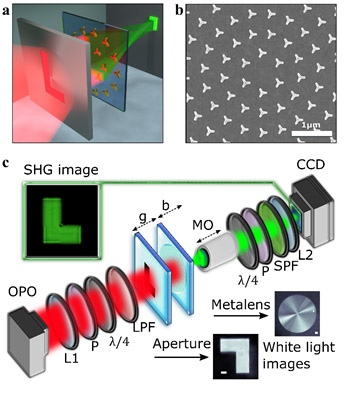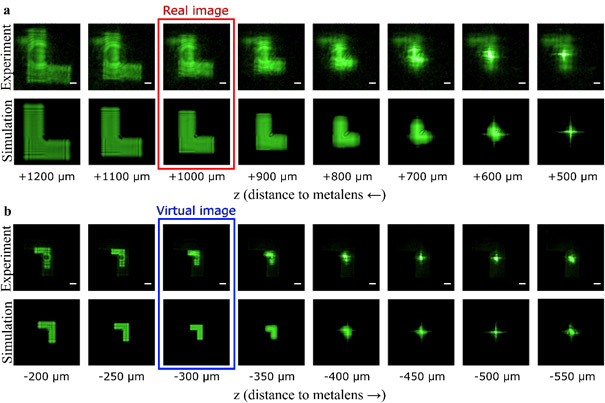Resources
 Part of the Oxford Instruments Group
Part of the Oxford Instruments Group
Expand
Collapse
 Part of the Oxford Instruments Group
Part of the Oxford Instruments Group
Plasmonic metasurfaces are engineered, subwavelength, sheet materials that consist of arrays with precisely arranged metallic meta-atoms, typically fabricated by standard electron beam lithography. These planar arrays can be used to spatially control optical beam parameters like phase, polarization, and amplitude [1]. We use this concept to fabricate nonlinear metalenses, with a dual functionality: on the one hand the incorporation of a lens-like phase profile and on the other hand a nonlinear harmonic generation process.
Recently, these nonlinear metasurfaces have gained much interest, because they provide new functionalities that are not feasible in the linear regime, such as nonlinear holography [2] or nonlinear optical encryption [3]. Here, we use nonlinear metalenses to study the image formation of real objects, which is not governed by the conventional thin lens equation [4].

Figure 1| Schematic concept and experimental setup. a. Illustration of the imaging concept: The L-shaped aperture is imaged on a screen with the help of the nonlinear metalens consisting of C3 nanoantennas. b SEM image of the plasmonic metalens. c L-shaped slot aperture is illuminated with fundamental beam. The insets show microscopy images of the L-shaped chromium aperture (thickness 100 nm) and of the metalens as well as the simulated SHG image (false color) at the camera position. λ/4 quarter waveplate; sCMOS, camera; L, lens; LPF, long-pass filter; OPO, optical parametric oscillator; P, polarizer; SPF, short-pass filter; MO, microscope objective lens. The scale bars correspond to 20 μm.
The concept of the nonlinear metalens is schematically shown (Figure 1a). The nonlinear lens is illuminated by infrared light, which carries information about the L-shaped aperture. The fundamental wave is partially converted to viridescent second harmonic wavelength and imaged to an image plane while the propagation of the fundamental wave remains unaffected by the metalens. To generate the lens-like phase profile for the second harmonic generation (SHG), we make use of the non-linear Pancharatnam-Berry (PB) phase. For a meta-atom with C3 rotational symmetry, a nonlinear phase of 3σθ is introduced to the SHG, where σ=±1 corresponds to the input right or left circular state of polarization (RCP or LCP) and θ represents the orientation angle of the C3 meta-atom. This concept allows the lens to work either as a convex or a concave nonlinear lens depending on the input circular polarization. Some of the very central meta-atoms are shown in a top view SEM image (Figure 1b). To demonstrate the imaging abilities of our nonlinear metalens, we illuminate the L-shaped aperture with an RCP Gaussian beam at 1085 nm wavelength and we expect the lens to work as a convex lens. As in the linear regime, the image formation depends on the object distance g, the image distance b and the focal length (f=500 μm) of the metalens (Figure 1c).
The image distance can be measured by changing the position of the microscope objective along the optical axis, and imaging different planes onto the camera. In contrast to the linear optical case, we can retrieve an inverted 1:1 SHG image of the L-shaped aperture when we place the lens at an object distance that matches the focal distance of the lens (g=-f). The image distance is measured to be b=2f (Figure 2a). In linear optics, this configuration would result in an image formation at infinity. For LCP input polarization and a concave nonlinear metalens, we can detect a virtual image at at b=-300 μm (Figure 2b). We support our findings by numerical simulations with the nonlinear beam propagation method.
For those nonlinear experiments, the choice of the imaging system is of particular importance. Because of the low conversion efficiency of the order 10-12 the experiments strongly benefit from high quantum efficiency at the SHG wavelength and very low readout noise. To address these demands, we used the Zyla 5.5-USB3 sCMOS camera. The camera features ultra-low noise performance of only 0.9 e- rms read noise and 60% maximum quantum efficiency at 600 nm. Furthermore, the image sensor is thermo-electrically cooled to 0°, which enables the device to work at a low dark current of 0.1 e-1/s/px.
Therefore, the device caN significantly reduce the overall noise while capturing images at low light intensities and long exposure times.
The user software Andor Solis provides helpful and intuitive functionalities like the automatic background correction or the AOI (area of interest) function, which we used to precisely determine the axial position of the lens focal spot or the sharpest image. Additionally, this system includes a software development kit, which allows comfortable sequential image recording. The Zyla 5.5 sCMOS camera and a motorized translational stage to move the microscope objective can be simultaneously controlled via MATLAB or LabVIEW.

Figure 2| 1:1 spin-dependent object imaging with nonlinear metalens. a First row: Measured SHG distribution for planes along the z-propagation direction behind the metalens showing the evolution of the image formation. A clear upright real image of the letter L is formed at z≈1000 μm. Second row: Corresponding simulation for the SHG distribution along the z-propagation based on beam propagation method in the nonlinear regime.b For the reversed spin state of the fundamental beam (LCP) the nonlinear metalens acts as a concave lens which images an upside-down virtual image of the letter L. Simulation and experiments show a clear image 300 μm before the metalens. Every single transverse plane is 200 x 200 μm² in size and the SHG is encoded in false-color on a logarithmic scale for better visibility.
[1] Alexander V Kildishev, Alexandra Boltasseva, and Vladimir M Shalaev. Planar photonics with metasurfaces. Science, 339(6125):1232009, 2013.
[2] Euclides Almeida, Ora Bitton, and Yehiam Prior. Nonlinear metamaterials for holography. Nature Communications, 7(1):1–7, 2016.
[3] Felicitas Walter, Guixin Li, Cedrik Meier, Shuang Zhang, and Thomas Zentgraf. Ultrathin nonlinear metasurface for optical image encoding. Nano Letters, 17(5):3171–3175, 2017.
[4] Christian Schlickriede, Naomi Waterman, Bernhard Reineke, Philip Georgi, Guixin Li, Shuang Zhang, and Thomas Zentgraf. Imaging through nonlinear metalens using second harmonic generation. Advanced Materials, 30(8):1703843, 2018.
Christian Schlickriede
Department of Physics
Paderborn University
Warburger Straße 100
33098 Paderborn, Germany
Phone: +49 (5251) 60-5861
E-mail: christian.schlickriede@upb.de
Web: http://physik.uni-paderborn.de/ag/ag-zentgraf/
Date: May 2020
Author: C. Schlickriede, T. Zentgraf
Category: Application Note
